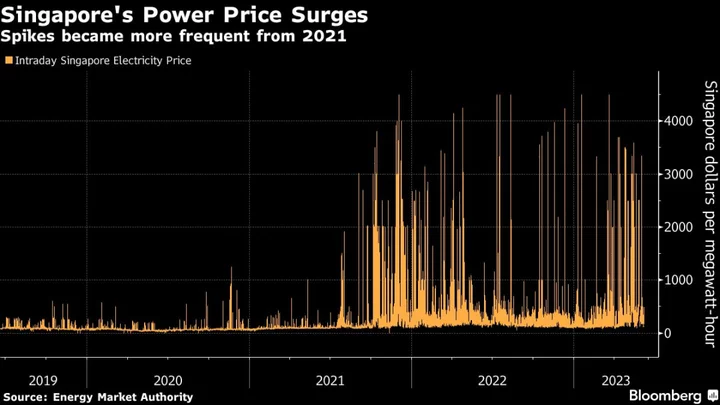Singapore is struggling to attract new players to its volatile power market, threatening to unwind reforms aimed at boosting competition and reducing electricity bills for consumers.
Surging spot power prices over the last two years prompted an exodus of retailers, after it became unprofitable to continue operations. The nation’s regulator introduced a price cap last month to help tame these wild price swings, but participants are calling for more action to help revive the fledgling futures market.
“I haven’t seen any new entrants in the last two years,” said Matthijs Guichelaar, chief executive officer of Flo Energy, one of the few independent retailers still active in the market along with seven incumbent power generation companies. “The futures market has zero liquidity.”
Singapore fully liberalized its power sector in 2018, for the first time allowing consumers to choose electricity providers. This resulted in a slew of independent retailers entering the wholesale electricity market to compete with the state-owned utility. Most, however, were forced to bow out from operations after spot power prices spiked.
Read More: Singapore’s Power Market Is Tighter Than Housing: Andy Mukherjee
The global energy crisis, which started to gain pace in 2021, dealt a heavy blow to energy retailers not just in Singapore but across the world in countries like the UK and Japan. Independent retailers don’t have power plants, and instead purchase electricity from the spot market for customers, like households and businesses.
That leaves the retailers particularly exposed as prices have jumped as much as 3,000% intraday. Singapore consumers are somewhat protected, as they are charged at a fixed rate.
Still, the lack of competition means residents have fewer options for more affordable providers. Consumers will see electricity bills that are almost 15% higher this quarter compared with the five-year average for the period — that’s tied more to higher prices for imported natural gas than to swings in the spot market.
A key hurdle for Singapore’s power market is the lack of an effective way to hedge the volatile prices. Liquidity in power futures, a type of contract that can help protect retailers from wild physical electricity price swings, has dried up since 2021.
Singapore introduced “market maker” incentives when it opened up the power sector, hoping liquidity would improve as more banks and trading houses joined. But the Energy Market Authority rolled those back as volumes didn’t improve.
The EMA is working with the industry and Singapore Exchange Ltd. on the next steps to take after current incentives expire, the authority said in a response to an email Friday.
One solution is to require Singapore’s power generators to act as market makers, according to Guichelaar. “That gives a very clear price discovery,” he said.
There is a desire to see new players in the power sector, but few new participants are emerging, according to David Broadstock, a senior research fellow and the head of the energy economics division at the National University of Singapore’s Energy Studies Institute. Some form of additional market intervention may be worth considering, he said.
“One may question whether the futures market pricing discovery process has become inefficient to the point that it may not be properly or fairly pricing future electricity supply contracts as low as they could be,” Broadstock said.
--With assistance from Ann Koh.









